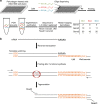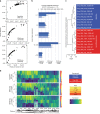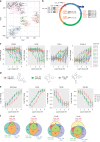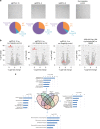DRUG-seq for miniaturized high-throughput transcriptome profiling in drug discovery
- PMID: 30333485
- PMCID: PMC6192987
- DOI: 10.1038/s41467-018-06500-x
DRUG-seq for miniaturized high-throughput transcriptome profiling in drug discovery
Abstract
Here we report Digital RNA with pertUrbation of Genes (DRUG-seq), a high-throughput platform for drug discovery. Pharmaceutical discovery relies on high-throughput screening, yet current platforms have limited readouts. RNA-seq is a powerful tool to investigate drug effects using transcriptome changes as a proxy, yet standard library construction is costly. DRUG-seq captures transcriptional changes detected in standard RNA-seq at 1/100th the cost. In proof-of-concept experiments profiling 433 compounds across 8 doses, transcription profiles generated from DRUG-seq successfully grouped compounds into functional clusters by mechanism of actions (MoAs) based on their intended targets. Perturbation differences reflected in transcriptome changes were detected for compounds engaging the same target, demonstrating the value of using DRUG-seq for understanding on and off-target activities. We demonstrate DRUG-seq captures common mechanisms, as well as differences between compound treatment and CRISPR on the same target. DRUG-seq provides a powerful tool for comprehensive transcriptome readout in a high-throughput screening environment.
Conflict of interest statement
The authors declare no competing interests.
Figures




Similar articles
-
Pooled CRISPR screening with single-cell transcriptome readout.Nat Methods. 2017 Mar;14(3):297-301. doi: 10.1038/nmeth.4177. Epub 2017 Jan 18. Nat Methods. 2017. PMID: 28099430 Free PMC article.
-
DRUG-seq Provides Unbiased Biological Activity Readouts for Neuroscience Drug Discovery.ACS Chem Biol. 2022 Jun 17;17(6):1401-1414. doi: 10.1021/acschembio.1c00920. Epub 2022 May 4. ACS Chem Biol. 2022. PMID: 35508359 Free PMC article.
-
Ultra-high-throughput single-cell RNA sequencing and perturbation screening with combinatorial fluidic indexing.Nat Methods. 2021 Jun;18(6):635-642. doi: 10.1038/s41592-021-01153-z. Epub 2021 May 31. Nat Methods. 2021. PMID: 34059827 Free PMC article.
-
Using high-throughput sequencing transcriptome data for INDEL detection: challenges for cancer drug discovery.Expert Opin Drug Discov. 2016;11(3):257-68. doi: 10.1517/17460441.2016.1143813. Epub 2016 Feb 6. Expert Opin Drug Discov. 2016. PMID: 26787005 Review.
-
A Perspective on the Future of High-Throughput RNAi Screening: Will CRISPR Cut Out the Competition or Can RNAi Help Guide the Way?J Biomol Screen. 2015 Sep;20(8):1040-51. doi: 10.1177/1087057115590069. Epub 2015 Jun 5. J Biomol Screen. 2015. PMID: 26048892 Review.
Cited by
-
Advancing Drug Discovery for Neurological Disorders Using iPSC-Derived Neural Organoids.Int J Mol Sci. 2021 Mar 6;22(5):2659. doi: 10.3390/ijms22052659. Int J Mol Sci. 2021. PMID: 33800815 Free PMC article. Review.
-
Cancer cell heterogeneity and plasticity: A paradigm shift in glioblastoma.Neuro Oncol. 2022 May 4;24(5):669-682. doi: 10.1093/neuonc/noab269. Neuro Oncol. 2022. PMID: 34932099 Free PMC article. Review.
-
DeepCellState: An autoencoder-based framework for predicting cell type specific transcriptional states induced by drug treatment.PLoS Comput Biol. 2021 Oct 5;17(10):e1009465. doi: 10.1371/journal.pcbi.1009465. eCollection 2021 Oct. PLoS Comput Biol. 2021. PMID: 34610009 Free PMC article.
-
TORNADO-seq: A Protocol for High-Throughput Targeted RNA-seq-Based Drug Screening in Organoids.Methods Mol Biol. 2023;2650:65-75. doi: 10.1007/978-1-0716-3076-1_6. Methods Mol Biol. 2023. PMID: 37310624
-
High-throughput identification of repurposable neuroactive drugs with potent anti-glioblastoma activity.Nat Med. 2024 Nov;30(11):3196-3208. doi: 10.1038/s41591-024-03224-y. Epub 2024 Sep 20. Nat Med. 2024. PMID: 39304781 Free PMC article.
References
Publication types
MeSH terms
LinkOut - more resources
Full Text Sources
Other Literature Sources
Molecular Biology Databases

